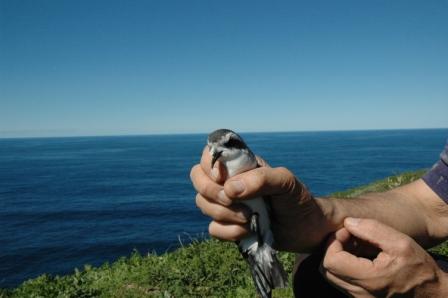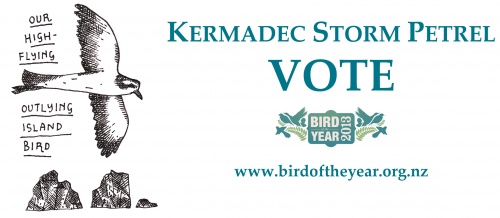Kermadecs Storm Petrel
OUR HIGH-FLYING OUTLYING ISLAND BIRD
One night on Macauley Island, in the Kermadec Islands group, in 1988, ornithologists Alan Tennyson and Graeme Taylor noticed something flitting around the Tilley lamp inside their tent. A close inspection of the tiny grey and white bird revealed a Kermadec storm petrel, a species known from only a handful of specimens shot at sea in the 1920s. The bird wasn’t nesting on Macauley, whose seabird population had been devastated by rats, cats and goats, but over subsequent years the birds were occasionally spotted at sea. In 2006, a Navy helicopter dropped Karen Baird and Mike Imber on Haszard Island – a rocky islet next to Macauley – to search for signs of the bird.
 Photo: Karen Baird
Photo: Karen BairdThe first Kermadec storm petrel found breeding – on top of Haszard Island.
“The area on top of the island is quite small and the ground is soft,” says Baird. “Mike stuck his hand down a burrow and out came a Kermadec storm petrel on an egg. We looked at the amount of habitat available and estimated there were 100 burrows at most, so maybe 100 breeding pairs.”
Haszard Island is a grass-topped lump of volcanic rock sticking sharply out of New Zealand’s northern ocean. The many species of seabirds that live in the Kermadec Islands can survive patrolling sharks, erupting volcanoes and tropical storms, but the rats, mice and cats introduced in the 19th century decimated many species. Haszard Island, though, has remained pest-free, providing a haven for this vulnerable seabird who spends months each year raising a single chick in an earthy burrow.
The Kermadec storm petrel (Pelagodroma albiclunis) is one of New Zealand’s endemic species – they’re found nowhere else in the world, and they are critically endangered.
The Kermadec storm petrel is one of the entrants in Forest & Bird’s annual Bird of the Year competition. “It’s a bird we know hardly anything about. How can one of our endemic birds be a total enigma? We want people to know about it, we want people to champion it; ultimately, we want to support scientists to study them and find out more about where they go, and when we find out that, we find out more about our ocean and how it’s working.” said campaign manager Bronwen Golder.













